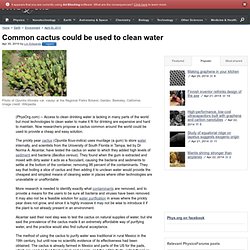

Common cactus could be used to clean water. (PhysOrg.com) -- Access to clean drinking water is lacking in many parts of the world but most technologies to clean water to make it fit for drinking are expensive and hard to maintain.

Now researchers propose a cactus common around the world could be used to provide a cheap and easy solution. The prickly pear cactus (Opuntia ficus-indica) uses mucilage (a gum) to store water internally, and scientists from the University of South Florida in Tampa, led by Dr Norma A. Alcantar, have tested the cactus on water to which they added high levels of sediment and bacteria (Bacillus cereus). World's Best Water Purifier May be the Cactus. Written by Megan Treacy on 27/04/10 Scientists from the University of South Florida have discovered the water purifying power of the prickly pear cactus.

An extract from the desert-dweller is very effective at removing sediment and bacteria from dirty H2O and, even better, it grows all around the world. Survival Water Containers - Hold, drink and Purify Water with the Prickly Pear Cactus. Water-filtration system that uses plants to extract arsenic from water. A water-filtration system that uses plants to extract arsenic from water supplies and allows the user to sell the poisonous substance at a profit has been voted the “Idea that will change the world” at the Global Design Forum in London today (+ interview).

Clean Water, developed by Oxford University MSc student Stephen Goodwin Honan, was voted the best of five world-changing ideas presented at the forum, held today at the Southbank Centre. Arsenic poisoning from contaminated water has been described as the “largest mass-poisoning in history” by the World Health Organisation, causing cancers that kill an estimated 1.2 million people in the developing world each year. Clean Water uses special, arsenic-absorbing plants, which are grown in a container. Water is pumped through the container and arsenic is trapped in a filter, and then absorbed by the plants where it poses no danger. There are no running costs and no specialist expertise required to maintain the system. Via: dezeen. 20 Air Purifying Plants. Houseplants Clean Indoor Air Pollution Home Top Plants. NASA calls it Sick Building Syndrome.

I know it as a stuffy house that needs a good airing, as my Mom put it. By the end of January, if it weren’t for the forest of houseplants in my home, I’d open the windows, despite the snow and freezing daytime temperatures. I did open them before I learned that tropical houseplants clean indoor air of pollution. Houseplants help rid the home of toxins such as benzene, formaldehyde, carbon dioxide and trichloroethylene, all chemicals that off-gas from man-made materials used to build and insulate a home. They can cause leukemia, liver disease and a myriad of cancers. Plants Clean Air and Water for Indoor Environments. Public Safety Originating Technology/NASA Contribution Although one of NASA’s goals is to send people to the far reaches of our universe, it is still well known that people need Earth.

We understand that humankind’s existence relies on its complex relationship with this planet’s environment—in particular, the regenerative qualities of Earth’s ecosystems. In the late 1960s, B.C. “Bill” Wolverton was an environmental scientist working with the U.S. military to clean up the environmental messes left by biological warfare centers. Plants Absorb Indoor Pollution. Plants Soak Up Indoor Pollution A home that's full of green plants greets you with an unmistakably different feeling.

The air is alive and clean, crackling with positive energy. 15 houseplants for improving indoor air quality. Kamal Meattle on how to grow fresh air. Wolverton Environmental Services. Most houseplants do consume a small amount of oxygen during the night.

However, it is an insignificant amount when compared to the overall volume of air in a room. Some plants such as the snake plant, orchid and bromeliad actually produce oxygen at night. Common houseplants that can be harmful to children if they chew on the leaves are golden pothos, English ivy, dieffenbachia, philodendron and syngonium. These are some of the commonly known plants but one should consult a trusted plant grower or medical source if concerned about a particular plant. 1. Copyright ©2013 Wolverton Environmental Services, Inc. Top 10 Natural, Eco-Friendly and Anti-Pollutant Houseplants. – Get rid of indoor pollution in a natural way You must have spent practically thousands of dollars to buy the latest vacuum cleaner and the latest floor cleaners that help you keep your house clean.

However, there comes a time when these machines fail to work leaving you to the unhealthy dust particles and other pollutants in your house. Rather than artificial machines, you must opt for natural pollution fighters that come in the form of plants. These plants are quiet unlike the noisy machines when you switch them off. Moreover, you do not have to throw hundreds of dollars to repair them. Hence, to get rid of pollution in your house in a natural way, you must go through the top 10 houseplants that you can buy. 1.The Feston Rose plant ( photo by missouristate ) While looking for a houseplant, you generally prefer the one’s that need the lowest maintenance.
This houseplant brilliantly tolerates highly saline conditions, lack of water, scorching heat and billowing winds.